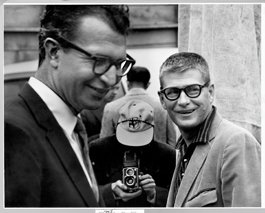home | metro santa cruz index | the arts | visual arts | review

Photo courtesy Monterey Jazz Festival
Take Five times 10: Dave Brubeck (left) with Monterey Jazz Festival founder Jimmy Lyons in the early days of the festival
Dave Brubeck
The venerable jazz pianist stops by Santa Cruz on the eve of Monterey JazzFest's 50th anniversary
By Alex Gilrane
The Monterey Jazz Festival, which celebrates its 50th anniversary at this weekend's typically star-studded show, was the brainchild of two unlikely impresarios: Ralph Gleason, a tweedy, pipe-smoking San Francisco music journalist, and Jimmy Lyons, a somewhat eccentric Big Sur resident who DJ'd a jazz show for the Salinas radio station KDON. And it never would have happened if not for a man who at the time seemed an unlikely representative of the jazz world, the bespectacled pianist Dave Brubeck, who returns this year to the fairgrounds, making a stop in Santa Cruz at the Rio Theatre first.
Gleason at the time was working for the San Francisco Chronicle, where he had gotten a job as the nation's first jazz critic (he later became famous as a Rolling Stone music columnist). After a decade of late nights in San Francisco's nightclubs covering the jazz scene, Gleason dreamed of seeing the music brought out into the light of day. He imagined "a sylvan setting with the best jazz people in the whole world playing on the same stage, having a whole weekend of jazz."
Lyons, his friend from down the coast, loved the idea. And he believed he had found the perfect setting at the Monterey Fairgrounds, with its 20 acres of oaks and its big horse-show arena.
There was only one problem: how to sell the idea of a jazz festival to the conservative city fathers who managed the fairgrounds.
Gleason's and Lyons' strategy for winning approval from the Monterey City Council was ingenious. They invited the local leaders to a private performance by the Dave Brubeck Quartet. Slam dunk. Following the show, 67 local businessmen contributed $100 each to back the festival.
Brubeck was a smart choice to introduce jazz to a bunch of provincial squares. He was practically a local—he's California born and bred—and his music was cool, sophisticated and gorgeously melodic. But this was no bait-and-switch trick. While Brubeck's brand of classical-influenced jazz was the perfect thing to calm a potentially fearful audience, it was no less adventurous than the hot, raucous stuff being played back East and down South.
Then as now, jazz was defined by a vast array of styles and sounds. The first Monterey Jazz Festival delivered stunning evidence of the music's variety. Louis Armstrong, who had helped invent the art form in New Orleans, headlined the event with a rousing performance, just released as Live at Monterey, 1958 on the new MJF Records label. Dizzy Gillespie's set was itself a far-ranging tour, veering from bebop to Latin stylings. The weekend also featured Gerry Mulligan's melodic inventiveness, Ernestine Anderson's soulful blues, Harry James' big-band pop and Billie Holiday's dark, sweet vocal poetry. The show was a sensation, and Monterey immediately earned a place on the map of American music.
Over the next 35 years, with Lyons at the helm as director, the jazz world continued to expand, and MJF continued on its mission to gather "the best jazz people in the world." More often than not, Monterey succeeded in presenting the biggest stars, as well as emerging artists who took the music in new directions. Toward the end of Lyons' reign, however, with his health failing, MJF had lost some of its edge, according to most accounts. But that turned around in 1993, when Lyons stepped down and the directorship was turned over to another unlikely leader, Santa Cruz's own Tim Jackson.
Jackson had made a name for himself as director at the Kuumbwa Jazz Center, which he had co-founded in 1978. Over the years, Kuumbwa had earned a nationwide reputation for managing to bring big-name acts to this small city, and also for its smart programming, which often featured talented young players on their way up.
Just as he made Monday nights at Kuumbwa a destination with his keen ear for the best contemporary jazz, Jackson has won accolades for breathing new life into MJF.
This year's program, though noteworthy as a landmark, is classic Monterey, and particularly typical of recent festival lineups, bringing together some justly revered old-timers and some hot new acts.
In addition to Brubeck himself, MJF 50 reunites several musicians who performed at the first Festival in 1958: Sonny Rollins, still one of the world's great sax men, who plays the main stage Sunday; Jim Hall, the brilliant guitarist, who will sit in with the Brubeck Quartet as a special guest; Benny Green, the great and somewhat underrated pianist; and Ernestine Anderson, who has never stopped touring the world.
In addition to these honored titans, this year's show includes an inspired collection of jazz superstars:
While the big-name shows on the Arena's Jimmy Lyons Stage have long ago sold out, it is still well worth a trip down Highway 1 for all or part the weekend. A grounds pass ($45 in advance; $50 at the gate) provides access to several smaller venues. The Garden Stage, Courtyard Stage and West Lawn offer the kind of outdoor settings that would make Ralph Gleason happy, while the Night Club, Dizzy's Den and Coffee House, all modestly converted county-fair barns, provide opportunities for more intimate musical encounters.
Some highlights:
THE DAVE BRUBECK QUARTET plays Thursday, Sept. 20, at 8pm at the Rio Theatre, 1205 Soquel Ave., Santa Cruz; tickets are $75/$40. For information on the Monterey Jazz Festival, visit www.montereyjazzfestival.org.
Send a letter to the editor about this story.
|
|
|
|
|
|